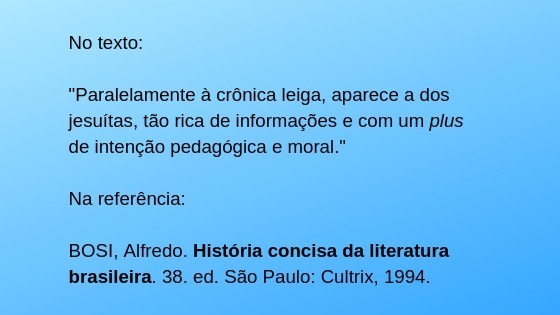An epigraph is a short sentence that appears at the beginning of a TCC or academic work. It confers formality, style and must be related to the theme of the work.
Therefore, it is very important to choose the epigraph well so that it is not simply a loose sentence.
So, for those of you who don't know what to put in the TCC epigraph, check it out below 24 examples of epigraphs with quotes from different areas.
Health area
- “May your medicine be your food, and your food be your medicine.” (Hippocrates)
- “The biggest mistake a man can make is to sacrifice his health to any other advantage..” (Arthur Schopenhauer)
- “Nursing is an art, and to realize it as an art, it requires such exclusive devotion, such rigorous preparation, as the work of any painter or sculptor.” (Florence Nightingale)
Law Area
- “Injustice anywhere is a threat to justice everywhere.” (Martin Luther King)
- “The end of the Law is not to abolish or restrict, but to preserve and expand freedom.” (John Locke)
- “The lawyer must suggest in such a discreet way the arguments that give him reason, that he leaves to the judge the conviction that he was the one who discovered them..” (Piero Calamandrei)
Administration and Management Area
- “The path to social and economic development – whether for a country or an organization – necessarily passes through the administration.” (Idalberto Chiavenato)
- “We can't predict the future, but we can create it.” (Peter Drucker)
- “There are three types of companies: Companies that try to take their customers where they don't want to go; companies that listen to their customers and then respond to their needs; and companies that take their customers where they don't yet know they want to go.” (Gary Hamel)
Architecture Area
- “Form follows function: this has been misinterpreted. They should be one, together in a spiritual meeting.” (Frank Lloyd Wright)
- “Architecture is above all construction, but construction conceived with the primary purpose of ordering and organizing space for a certain purpose and aiming at a certain intention.” (Oscar Niemeyer)
- “Architecture is the art that determines the identity of our time and improves people's lives.” (Santiago Calatrava)
Psychology Area
- “Whoever looks outside dreams, whoever looks inside wakes up.” (Carl Jung)
- “Intelligence is the only way we have to master our instincts.” (Sigmund Freud)
- “We are what we think. All that we are arises with our thoughts. With our thoughts we make our world.” (Buddha)
Physical Education Area
- “Education must provide body and soul with all the perfection and beauty they can have..” (Plato)
- “To know oneself is to dominate, to dominate is to triumph.” (Jigoro Kano)
- “Sport doesn't build character, it reveals it.” (Heywood Hale Broun)
Education and Pedagogy Area
- “Teaching is not transferring knowledge, but creating the possibilities for your own production or construction.” (Paulo Freire)
- "Education has bitter roots, but its fruits are sweet." (Aristotle)
- “To truly educate is not to teach new facts or enumerate ready-made formulas, but to prepare the mind to think.” (Albert Einstein)
Motivation Area
- “Persistence is the path to success.” (Charles Chaplin)
- “Vitality is demonstrated not just by persistence, but by the ability to start over.” (F. Scott Fitzgerald)
- “Man would not have achieved the possible if, over and over again, he had not tried the impossible.” (Max Weber)
What is the formatting of the TCC title in the ABNT Rules?
According to ABNT standards, the epigraph is one of the optional items in the monographs and the course completion papers (TCC). Whoever chose to place the epigraph in the TCC must follow the rules:
- Source: Arial (size 10) or Times New Roman (size 12). The font must be in agreement with the rest of the work, that is, if Arial was used, the epigraph must also follow this pattern.
- Alignment: Alignment is justified with 7.5 cm indentation from the left margin.
- Spacing: the space between lines must be 1.5.
- Phrase: the citation text must be in italics.
- Author: the author's name must be right-aligned and in italics.
To learn more about the TCC, check out the texts as well:
- Approval sheet (ABNT standards)
- TCC Summary: how to do in ABNT standards (with an example)
- Acknowledgments from TCC (ready model and examples)


